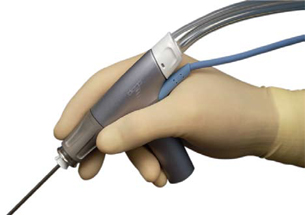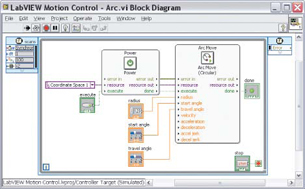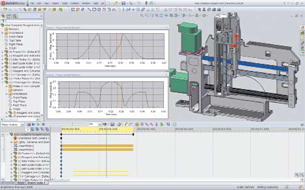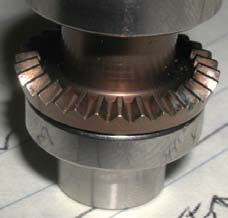Reinventing Machine Design Part 2: Synergy with LabVIEW and SolidWorks, 2 in a Series
To achieve the level of communications and breadth of knowledge demanded by mechatronics, a corporate cultural revolution is needed.
March 28, 2009
By Tom Kevan
 Figure 1: A. Gyrus ENT, a supplier of surgical devices, and IDEO, a global design firm, developed the Diego Powered Dissector System, a medical device used by otolaryngology surgeons through a highly collaborative process. Designers, engineers, and surgeons identified common problems with traditional tools and produced a superior device. Image courtesy of IDEO |
The changes required to make the transition to a mechatronic methodology are tantamount to a clash of cultures, bringing about the collision of old and new engineering practices. Under the new regimen, mechanical, electrical, and control engineers must view design problems differently, acquire additional training, develop a common language, and embrace a fundamentally different mindset. Inertia poses the greatest obstacle. The goal becomes greater synergy.
Blind Spots
Why would you want to go through all that effort and turmoil? There are a lot of good economic reasons for adopting mechatronics: shorter time to market, fewer physical prototypes (and thus lower costs), reduced number of fixes at the end of the development cycle, and generally better quality products (see Figure 1). In addition, there is also a desire to avoid the negative consequences of the traditional approach.
The fact is the old approach to design comes with a number of blind spots—failings that create opportunities for, at best, poor results, or worse, nothing short of disaster. Consider the following examples.
New products require more and more power. Almost across the board, heat is an issue. In these cases, thermal management often falls through a crack between electrical and mechanical engineering. Electrical engineers are responsible for careful component selection to create, for example, a circuit board that is power efficient and generates as little heat as possible. This is usually accomplished with sophisticated software, power planes, and low-power components. Mechanical engineers tackle the problem with fluid cooling and low-noise fans. The point here is that these disciplines cannot optimize the device if they operate independently.
A more extreme example of a blind spot can be seen in the Apollo 1 tragedy. On January 27, 1967, a flash fire killed astronauts Roger Chaffee, Ed White, and Gus Grissom aboard the spaceship as they were rehearsing launch procedures. The atmosphere inside the capsule was pure oxygen, which helped avoid problems that occur if there is nitrogen in the environment. From a purely mechanical and electrical point of view, the oxygen posed no problems. It didn’t occur to anyone that if you have a pure oxygen environment and prototype wiring, one spark could ignite the oxygen and create a terrible fire. It was the gap between the disciplines—the bioengineers, mechanical engineers, and electrical engineers—that led designers to overlook the threat.
 Figure 2: National Instruments’ LabVIEW graphical programming language is a familiar engineering tool relevant to a broad range of disciplines that visually captures design intent and interdependencies. The software’s easy-to-use high-level function blocks enable motion programming to begin as soon as a CAD model is created. Image courtesy of National Instruments |
“The things that unidisciplinary engineers don’t get when creating electromechanical systems are the interdependencies and significant issues that fall in the cracks between the disciplines,” says Dave Blakely, director of technology strategy at IDEO, a design consultancy based in Palo Alto, CA. “When you run into complex systems, you get completely unexpected interactions between electrical and chemical systems or between mechanical and electrical systems. What a lot of engineers in the various disciplines don’t get is how extremely important integration among the engineering disciplines is.”
Hurdles
A number of obstacles stand in the way of achieving the level of integration called for by the mechatronic methodology. Most of these fall under the general category of culture.
The first hurdle is the very psychological profile of the engineer. “The most general problem I see has to do with the sort of individual one often sees in engineering,” says IDEO’s Blakely. “Engineering is a field that often attracts people who are somewhat introverted and smart. They like digging deeply into a specific technical problem and solving it. That’s a solo activity. But what happens if you’ve got to become more extroverted in your work style and consider the requirements of other disciplines? Messy realities force discussion and compromise. That doesn’t come easy to the engineering mindset. It’s frustrating to come to terms with the limitations required by other disciplines. There’s a messiness inherent in interdisciplinary work.”
The same mindset that can hinder integration, however, follows a common problem-solving approach. If you’re an engineer, you’re comfortable with engineering thinking. Any engineer is going to look at a problem, assess the risk areas, come up with various countermeasures, build a succession of prototypes, and mitigate risks. But the common perspective of the various engineering disciplines ends here.
“Mechanical and controls engineers have two very different perspectives on the machine,” says Mark Price, engineering technology manager of Assembly & Test Worldwide. “On the mechanical end of things, we are very much concerned with the packaging of the machine, ensuring multiple motions do not occupy the same space at the same time, guaranteeing things are sized and speced properly to carry the loads and take the forces that the machine is going to experience—all very mechanical in nature. Control engineers look at things very differently. They have little concern about the packaging, size of the equipment, or how fast things can move. They’re more concerned with what happens at what point in time, when something is going to happen, and the status of the inputs and outputs.”
 Figure 3: SolidWorks’ realistic simulations enable design teams to visualize the machine operating under the control of LabVIEW function blocks and obtain analysis data needed to optimize the design and discover problems long before tooling. Image courtesy of National Instruments |
These disparate perspectives reinforce the inherent limitations of the traditional “waterfall approach” to design and development, where mechanical design is followed by electrical and control engineering. Communication and collaboration, along with concurrent design, are essentially blocked by individual disciplines functioning in silos. In turn, the insular design functions are perpetuated by often-present disinterest in changing work practices and adopting the mechatronic approach.
“Even after some engineers have seen the benefits of mechatronics, I still get the feeling that maybe some of them just want to go back and do the design the way they are used to doing it,” says Rob Shaffer, electrical staff engineer at Siemens Medical. “It’s almost a culture change.”
Creating Common Ground
Underlying the disparate perspectives of the various engineering disciplines is an absence of common language, concepts, and metrics. This inhibits the collaboration and communications required by mechatronics by fostering misunderstandings and the misinterpretation of terms.
“The differences between engineering disciplines would be vocabulary and conceptual. Everybody comes with their own definitions or vocabulary about the process, machine, or components,” says Rob Aleksa, the corporate control systems manager at Procter & Gamble Co. “The challenge is to create a commonality in understanding what the design is supposed to be and what the vocabulary is.”
The process of building a shared language begins in the areas where the disciplines interact. “One develops a shared vocabulary at the point of intersection between the disciplines,” says IDEO’s Blakely. “There’s overlap around particular words, such as EMI shields, grounding, and bypassing. Electrical and mechanical engineers need to develop a shared vocabulary around those technical points of intersection. It gives them a deeper appreciation of the challenges each faces.”
Take the development of a shared language one step further. Engineers need to broaden themselves by cultivating an understanding of the basics of other disciplines.
“We’re not asking engineers to become experts in another field,” says Blakely. “Go ahead and define people as, say, mechanical engineers, but give them permission to dabble so that they can do basic electrical engineering effectively—read schematic diagrams and specify to an electrical engineer what needs to be done.”
“The idea is to get both disciplines to understand common performance measures so that they are talking the same language,” says Procter & Gamble’s Aleksa. “Mechanical folks need to have some understanding of control theory, and controls engineers need to understand something about mechanical design because the components the mechanical engineer selects have a big impact on the performance of the machine.”
 Figure 4: In developing the Diego Powered Dissector System, the Gyrus ENT-IDEO team designed the gear assembly to enable better precision and reduced operator fatigue. Image courtesy of IDEO |
Software Tools
Software applications and tools are available that enable the enhanced communications called for by mechatronics. Falling into the same category as a shared language and common engineering concepts, these software applications provide a common reference or model of the machine being designed, using simulation and animation to allow all members of the design team to see how it will function and where interdependencies exist.
Two of these software packages are National Instruments’ LabVIEW (see Figure 2) and SolidWorks’ 3D CAD design software. The beauty of both applications is the fact that a broad spectrum of engineers are familiar with them.
While LabVIEW has targeted control engineers, all disciplines benefit from using it. “LabVIEW is about prototyping complex instruments,” says IDEO’s Blakely. “It hastens development by offering a nice common platform for many disciplines to use to create prototypes. The information is made relevant to a variety of different disciplines.”
“Engineers in house—electrical, mechanical, and software—have a pretty good understanding of LabVIEW,” says Siemens’ Shaffer. “They’re familiar with the graphical programming language. It’s one snapshot that everybody can use as a reference. It is a mechanism for different perspectives—the mechanical, electrical, and control. All can see what’s going on, where the interdependencies are, what the choices are, and how well they work.”
SolidWorks provides the same broad audience with a common view of the machine being designed, even though its primary users are mechanical engineers (see Figure 3). “Within SolidWorks, we’ve used animation to help communicate to the controls engineer what the machine will look like and the sequence of its functions,” says Assembly & Test’s Price.
A Time for Change
Change is never easy, no matter how compelling the motivating circumstances. This is certainly true for the companies and engineers involved in machine and device design. Part 1 of this series (Feb. 2009 DE) spelled out the many good reasons for moving from the traditional design approach to the mechatronic methodology. To create sophisticated cutting-edge devices or machinery (see Figure 4), design houses will need to break down the silos populated by individual engineering disciplines and combine mechanical, electrical, and control perspectives in a holistic solution.
In part 3, we’ll take a look at successful deployments of this shift in culture.
More Info
Assembly & Test Worldwide
Dayton, OH
IDEO Inc.
Palo Alto, CA
Procter & Gamble
Cincinnati, OH
Siemens Healthcare
Malvern, PA
Tom Kevan is a New Hampshire-based freelance writer specializing in technology. Send your comments about this article to [email protected].
Subscribe to our FREE magazine, FREE email newsletters or both!
About the Author
DE’s editors contribute news and new product announcements to Digital Engineering.
Press releases may be sent to them via [email protected].






